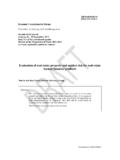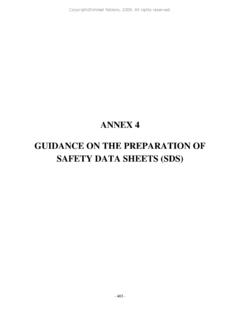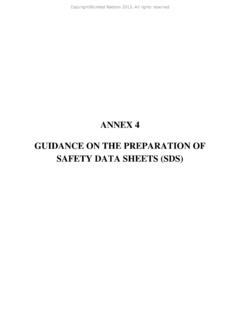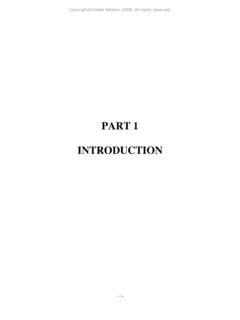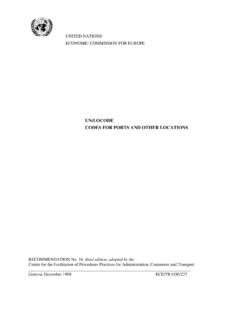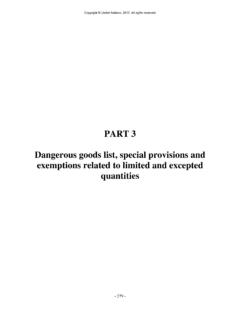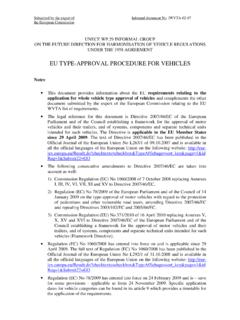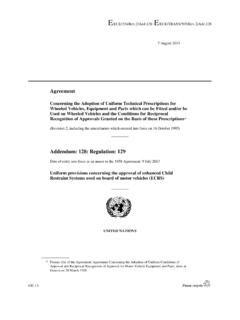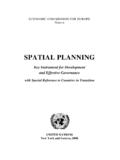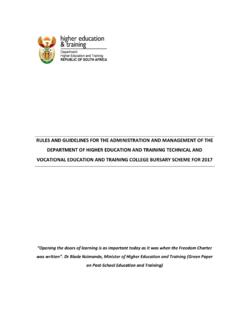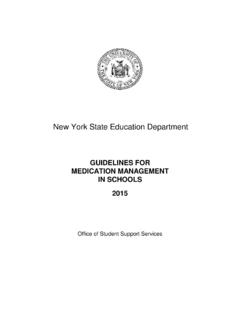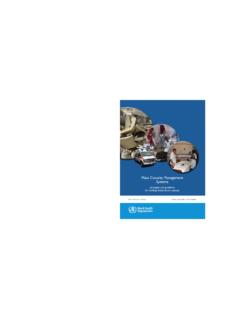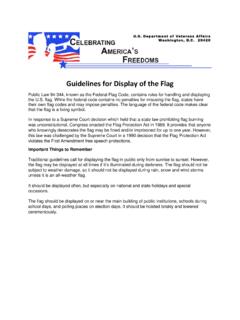Transcription of LAND ADMINISTRATION GUIDELINES - UNECE
1 _____ land ADMINISTRATION GUIDELINES 1 ECE/HBP/96 ECONOMIC COMMISSION FOR EUROPE Geneva land ADMINISTRATION GUIDELINES With Special Reference to Countries in Transition UNITED NATIONS New York and Geneva, 1996 _____ land ADMINISTRATION GUIDELINES 2 NOTE Symbols of United Nations documents are composed of capital letters combined with figures. Mention of such a symbol indicates a reference to a United Nations document. The designations employed and the presentation of the material in this publication do not imply the expression of any opinion whatsoever on the part of the Secretariat of the United Nations concerning the legal status of any country, territory, city or area, or of its authorities, or concerning the delimitation of its frontiers or boundaries. ECWHBP196 I UNITED NATIONS PUBLICATION Sales No ISBN 92-1-116644-6 _____ land ADMINISTRATION GUIDELINES 3 PREFACE In 1993 the United Nations Economic Commission for Europe (ECE) launched an initiative to strengthen land ADMINISTRATION capabilities, mainly for countries in east and central Europe.
2 The main purpose was to identify the current needs and problems related to land ADMINISTRATION in these countries, and for experts both from countries in transition and from the west to share views and experiences. ECE also sought to assess the opportunities for applying methods, policies and procedures of land ADMINISTRATION similar to those that evolved over a long period of time in the market economies of the ECE region. In 1993 a seminar on reform of real property, land registration and cadastre took place in Copenhagen (Denmark). To follow up the seminar, workshops were organized in Austria, Croatia, Hungary, Latvia, the Netherlands and Romania. In parallel, and with input from these workshops, a task force was established by the ECE Committee on Human Settlements to prepare the present GUIDELINES on land ADMINISTRATION .
3 The task force consisted of Messrs. Friedrich HRBEK (Austria), Branimir GOJCETA (Croatia), GAbor REMETEY-FULOPP (Hungary), Jan BROUWER (Netherlands), Helge ONSRUD (Norway), Virgil PAMFIL (Romania), Jim WIDMARK (Sweden) and Peter DALE (United Kingdom), Chairman of the task force. These GUIDELINES define land ADMINISTRATION as the process whereby land and the information about land may be effectively managed. They are mainly written for senior governmental staff and politicians engaged in land ADMINISTRATION issues. The aim is to out-line the benefit of having a relevant and reliable land information system in place. The GUIDELINES are based on the assumptions that: (i)Access to food and shelter are fundamental human needs; (ii)Security of tenure is essential for an effective housing policy; (iii)Certainty in the legal status of land is essential for efficient agricultural production; (iv)Investors in a market economy require a formal structure of land and property rights; (v) Sustainable development is dependent on the State having overall responsibility for managing information about the ownership, value and use of land , even though the private sector may be extensively involved; and (vi) Both land and information about land are resources that must be husbanded in order to achieve economic growth.
4 The GUIDELINES are in accord with article I of the First Protocol to the European Convention on Human Rights signed in Rome on 4 November 1950. That article states: Every natural or legal person is entitled to the peaceful enjoyment of his possessions. No one shall be deprived of his possessions except in the public interest and subject to the conditions provided for by law and by the general principles of international law. The GUIDELINES identify the factors that should be taken into account in developing the legislation, organization, databases and maps, as well as the funding mechanisms, required to implement and maintain a solid land ADMINISTRATION system, frequently referred to either as ;I cadastre or a land registration system. _____ land ADMINISTRATION GUIDELINES 4 The initial investment in a new land ADMINISTRATION system may involve spending mil-lions of dollars and the processes may take between 5 and IO years.
5 Such an investment and time-scale are however essential if economic development is to be sustainable. The GUIDELINES draw primarily on experiences in eastern and western Europe. All western systems of cadastre and land registration have been established for a long time but many have been built on traditional skills that have in the past not necessarily focused on all the needs of users. They were based on manual, not digital, methods although most are now in the process of introducing computerization. Like their eastern European counterparts they are changing to meet the needs of a modern society. Transition countries can learn much from western experiences. They need however to build their own systems within their own social, economic and cultural environments.
6 These GUIDELINES should help them to consider alternative ways to meet modern requirements. _____ land ADMINISTRATION GUIDELINES 5 CONTENTS Preface iii Executive summary 1 Chapter I. land and land ADMINISTRATION A. land as a resource 3 B. Cadastres and land registration 3 C. land management and land reform 5 D. land ADMINISTRATION 6 E. The benefits of a good land ADMINISTRATION system 7 F. Institutional issues 9 G. The role of computerization 11 H. Recommendations 11 II. The legal framework A. The legal status of land and real property 13 B. land tenure 15 C. Deeds registration and title registration 15 D. Adjudication of title to land 18 E. Boundaries 19 F.
7 Cadastral surveying 21 G. land parcel information 22 H. Recommendations 22 III. Financial matters A. Value and the valuation of land 25 B. Taxing land and property 28 C. Central valuation agencies 29 D. land and property markets 30 E. Costs and benefits of land ADMINISTRATION 31 F. Financing and sources of funding 35 G. Marketing land registry and cadastral data 35 H. Recommendations 37 IV. land -use planning A. The role of the cadastre in physical planning 39 B. land -use planning in urban centres 40 C. land consolidation and reallocation 42 D. Environmental monitoring and geographic information systems 43 E. Recommendations 45 V. Institutional arrangements _____ land ADMINISTRATION GUIDELINES 6 A.
8 land policy 47 B. land ADMINISTRATION activities 47 C. land information management 47 D. Organization and management 48 E. Recommendations 58 VI. Technical matters A. Control surveys 59 B. Cadastral surveying and mapping 61 C. Electronic data processing for land ADMINISTRATION 63 D. Recommendations 65 VII. Procedures for introducing a land ADMINISTRATION system A. The determination of user needs 67 B. The creation of new administrative and organizational structures 68 C. The preparation of new legislation 69 D. The adjudication and determination of rights in land 70 E. The surveying of land and property boundaries 71 F. The management of land information 72 G. The establishment of financial management procedures 74 H.
9 Developing awareness in the user community 75 I. Recommendations 75 ANNEX: The experience of Hungary in modernizing a land registration system 77 Glossary of terms 89 References 94 _____ land ADMINISTRATION GUIDELINES 7 EXECUTIVE SUMMARY These GUIDELINES are based on the assumption that a formal system is necessary to register land and property and hence to provide secure ownership in land , investments and other private and public rights in real estate. A system for recording land ownership, land values, land use and other land -related data is an indispensable tool for a market economy to work properly, as well as for sustainable management of land resources. All industrialized nations with a market economy maintain some sort of land register system that fulfils the above requirements.
10 These GUIDELINES use the term land to refer to the objects to which mortgages and other data are to be connected. Real estate is an alternative term. In practice a land ADMINISTRATION system can incorporate various basic objects or units, land parcels being the most common. Real estate can consist of one or several land parcels. Many countries also allow buildings or parts of buildings to be registered as separate real estates, as well as structures under or above the surface. The latter are referred to as properties in strata. Defining the basic units is a major element in the design of any land information system. A good land ADMINISTRATION system will: (i) Guarantee ownership and security of tenure; (ii) Support land and property taxation; (iii) Provide security for credit; (iv) Develop and monitor land markets; (v) Protect State lands; (vi) Reduce land disputes; (vii) Facilitate land reform; (viii) Improve urban planning and infrastructure development; (ix) Support environmental management; (x) Produce statistical data.
